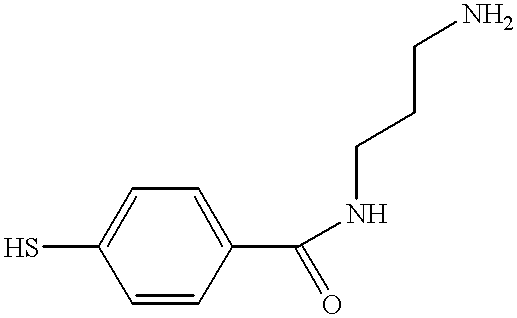Organo luminescent semiconductor nanocrystal probes for biological applications and process for making and using such probes
a luminescent semiconductor and nanocrystal technology, applied in the direction of scanning probe microscopy, material analysis, natural mineral layered products, etc., can solve the problem of difficult simultaneous or even non-simultaneous detection or discrimination between the presence of a number, and the limitation of the number of different color organic dye molecules which may be utilized simultaneously or sequentially, etc. problem
- Summary
- Abstract
- Description
- Claims
- Application Information
AI Technical Summary
Problems solved by technology
Method used
Image
Examples
example 2
To illustrate the formation of luminescent semiconductor nanocrystal compound (comprising glass-coated semiconductor nanocrystals linked to a linking agent), 50 .mu.l of 3-mercaptopropyl-trimethoxy silane was added to 40 ml of an anhydrous solution of 25 vol. % dimethylsulfoxide in methanol, and the pH was adjusted to 10-11 using (CH.sub.3).sub.4 NOH.5H.sub.2 O. 10 mg of tris-octylphosphine oxide coated CdSe / CdS core-shell particles, prepared by the technique described in the aforementioned Peng, Schlamp, Kadavanich, and Alivisatos article, were then dissolved in this solution, and stirred for several hours. The solution was diluted with 40 ml of methanol adjusted to a pH of 10 with (CH.sub.3).sub.4 NOH.5H.sub.2 O, and heated for 1 hour at 69.degree. C. The solution was stirred for an hour, and 40 ml of a 90 vol. % methanol / 9.89 vol. % H.sub.2 O / 0.1 vol. % trimethoxysilylpropyl urea / 0.01 vol. % aminopropyl-trimethoxy silane solution which had been stirring for at least an hour, was ...
PUM
| Property | Measurement | Unit |
|---|---|---|
| size | aaaaa | aaaaa |
| wavelength band | aaaaa | aaaaa |
| wavelength band | aaaaa | aaaaa |
Abstract
Description
Claims
Application Information
 Login to View More
Login to View More - R&D
- Intellectual Property
- Life Sciences
- Materials
- Tech Scout
- Unparalleled Data Quality
- Higher Quality Content
- 60% Fewer Hallucinations
Browse by: Latest US Patents, China's latest patents, Technical Efficacy Thesaurus, Application Domain, Technology Topic, Popular Technical Reports.
© 2025 PatSnap. All rights reserved.Legal|Privacy policy|Modern Slavery Act Transparency Statement|Sitemap|About US| Contact US: help@patsnap.com



